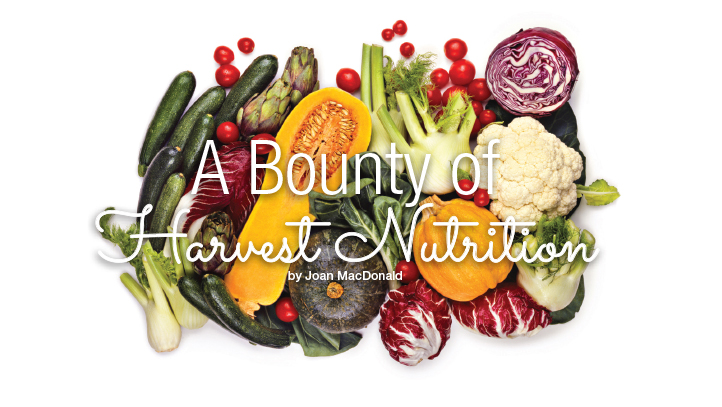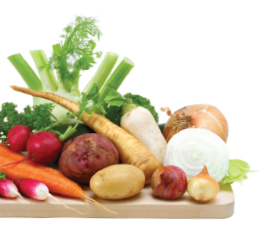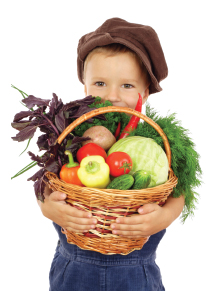
Along with the bright
colors of fall’s harvest, the
Hudson Valley’s cornucopia
of vegetables and fruits offers a
bounty of nutrients.
The plentiful harvest can provide many opportunities to improve your diet, says Roufia Payman, Northern Dutchess Hospital's director of Outpatient Nutrition Education. Paymen is a nutritionist who has always been passionate about the benefits of fresh, healthy foods. Ask her which fall vegetables should be on your shopping list, and she will respond enthusiastically: “Sweet potatoes, pumpkins, butternut and acorn squash, brussel sprouts, and cabbage are all good. Brussel sprouts and cabbage are packed with vitamins A and C, and they are all high in fiber.”
Payman touts the benefits of cauliflower too, which she calls the white broccoli. Cauliflower and other cruciferous vegetables are especially high in a class of organic compounds known as glucosinolates.“ These compounds are thought to help prevent some types of lung cancer,” says Payman. “Also, everything in the cabbage family, including brussel sprouts, is high in natural antibiotics, so it’s important to eat them during cold and flu season. Kale is very nutritious, as are beets, which can help protect the liver and lower blood pressure.”
Sweet potatoes, pumpkins,
butternut and acorn squash, brussel sprouts, and
cabbage OH MY!
And then there are pumpkins. “People come to the Hudson Valley to pick pumpkins,” says Payman. “Pumpkins and sweet potatoes are high in beta carotene. Pumpkin seeds are also an excellent source of omega-3 fatty acids.”
Payman also praises the often-overlooked root vegetables. She says, “Rutabaga and turnips are high in fiber and a good source of calcium. Eating them reduces your risk of cancer. They are really super foods and very important to eat as the days grow shorter. If you are feeling a little blah, make some soup with lots of root vegetables.”

Soup is a handy way to enrich your vegetable intake, but there are other ways to savor veggies. Payman suggests roasting vegetables, such as beets and squash, to bring out their sweet flavor. Or make a salad with Hudson Valley apples, beets, and walnuts, dressing it in a mixture of low fat Greek yogurt, mustard, and apple cider vinegar.
How does fresh local produce stack up against what’s available in the supermarket? Buying your vegetables from local farm stands and farmers is important for several reasons, she says. While the USDA says that, nutritionally speaking, it doesn’t matter if you buy fresh vegetables or frozen ones, there are other reasons it is important. Buying local helps the environment because the vegetables don’t have to travel far to get to you; it boosts the local economy; and local produce is tastier because it is so much fresher.
Buying local helps the
environment because the
vegetables don't have to
travel far to get to you.
“I want everyone to eat vegetables,” says Payman. “If you are going to skip eating fruits and vegetables because you can’t get them fresh, it’s better to eat them frozen than not at all. In the summer I eat local berries, but in the winter I might use frozen ones in my cereal.” Payman also thinks it’s worth it to buy locally and freeze fruits and veggies for later on. “People I know buy berries and freeze them for the whole year."
Several decades ago most people only had access to produce that was seasonally available, so getting something like strawberries in winter was difficult. And In the fall you only ate fall vegetables. Now, supermarket goers can buy fruits and vegetables flown in from around the world. Is there any advantage to eating food that is actually in season where you live?
“Seasonal vegetables are better,” says Payman. “That’s what nature has planned for us. But if the only vegetables you can get are frozen that’s what you should eat. I see so many children in my practice who already have high blood pressure because they eat a terrible diet.”

Payman offers “Food Fun Fitness” classes for children ages 8 to 12, so she knows how to encourage kids to eat a healthier diet. The first step is to get them involved. “You have to take them food shopping and involve them in the kitchen. Let them clean vegetables if they are young, or cut them if they are older,” she advises.
She offers a few tips to encourage kids to eat more veggies:
- �Kids usually like roasted vegetables.
- Pair raw vegetables, such as broccoli and cauliflower, with a yogurt dipping sauce.
- Fill celery stalks with almond or peanut butter.
Put raisins on top.
- Melt low fat cheese on broccoli for a colorful tasty snack.
- Make kale or sweet potato chips.
- Make it pretty.
Cut up summer tomatoes and serve with cheese and basil and olive oil.
- Set a good example.
If the whole family eats healthy, they will.
- �Take kids to the farmer’s markets and let them help choose what you will eat.
- Take kids to farms and let them see vegetables growing.
- Let children grow their own vegetables. If you don’t have a lot of room, they can grow herbs.
“Planting a garden nutures their
interest in food and helps them
become more self-confident,”
remarks Payman.

The Iranian native relates her own interest in healthy eating to a childhood spent on the Caspian Sea. She grew up with plenty of fresh healthy food: “We had walnut, orange, peach, cherry, and pomegranate trees, and we had our own vegetables."
“I was always interested in food, but as time passed I became more passionate about the subject. Food is fuel. I believe food should be your medicine. I would not want medicine to be my food.”
In her job as a hospital nutritionist, she helps patients who have diabetes, high blood pressure, weight problems, and arthritis learn how to eat better.
“Good food is love,” she says.
“It nurtures your body and soul.”

